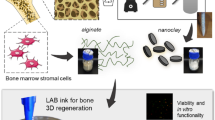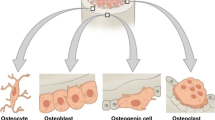Abstract
The purpose of this study has been to investigate the possible effects of the normal joint cavity environment on chondrocytic differentiation of bone-marrow-derived mesenchymal stem cells (MSCs). Autologous bone marrow was aspirated from the iliac crest of male sheep. MSCs were purified, expanded, and labeled with the fluorescent dye PKH26. Labeled MSCs were then grown on a three-dimensional porous scaffold of poly (L-lactic-co-glycolic acid) in vitro and implanted into the joint cavity by a surgical procedure. At 4 or 8 weeks after implantation, the implants were removed for histochemical and immunohistochemical analysis. The cells labeled with red fluorescent PKH26 in the implants expressed type II collagen and synthesized sulfated proteoglycans. However, the osteoblast-specific marker, osteocalcin, was not detected by immunohistochemistry indicating that the implanted MSCs had not differentiated into osteoblasts by being directly exposed to the normal joint cavity. To investigate the possible factors involved in chondrocytic differentiation of MSCs further, we co-cultured sheep MSCs with the main components of the normal joint cavity, viz., synovial fluid or synovial cells, in vitro. After 1 or 2 weeks of co-culture, the MSCs in both co-culture systems expressed markers of chondrogenesis. These results suggest that synovial fluid and synovium from normal joint cavity are important for the chondrocytic differentiation of adult bone-marrow-derived MSCs.









Similar content being viewed by others
References
Bradham DM, Passaniti A, Horton WE (1994) Mesenchymal cell chondrogenesis is stimulated by basement membrane matrix and inhibited by age-associated factors. Matrix Biol 14:561–571
Butnariu-Ephrat M, Robinson D, Mendes DG, Hoperin N, Nevo Z (1996) Resurfacing of goat articular cartilage by chondrocytes derived from bone marrow. Clin Orthop 330:234–243
Caplan AI (1991) Mesenchymal stem cells. J Orthop Res 9:641–650
Caplan AI, Bruder SP (2001) Mesenchymal stem cells: building blocks for molecular medicine in the 21st century. Trends Mol Med 7:259–264
Elves MW (1974) A study of the transplantation antigens on chondrocytes from articular cartilage. J Bone Joint Surg 56B:178–185
Gilding DK, Reed AM (1979) Biodegradable polymers for use in surgery-polyglycolic/poly (lactic acid) homo- and copolymers: 1. Polymer 20:1459–1464
Goshima J, Goldberg VM, Caplan AI (1991) The osteogenic potential of culture-expanded rat marrow mesenchymal cells assayed in vivo in calcium phosphate ceramic blocks. Clin Orthop 262:298–311
Grande DA, Southerland SS, Manji R, Pate DW, Schwartz RE, Lucas PA (1995) Repair of articular cartilage defects using mesenchymal stem cells. Tissue Eng 1:345–353
Haynesworth SE, Reuben D, Caplan AI (1998) Cell-based tissue engineering therapies: the influence of whole body physiology. Adv Drug Deliv Rev 33:3–14
Hunziker EB (1999) Articular cartilage repair: are the intrinsic biological constraints undermining this process insuperable? Osteoarthritis Cartilage 7:15–28
Jacobs RA, Perrett D, Axon JM, Herbert KE, Scott DL (1995) Rheumatoid synovial cell proliferation, transformation and fibronectin secretion in culture. Clin Exp Rheumatol 13:717–723
Johnstone B, Hering TM, Caplan AI, Goldberg VM, Yoo JU (1998) In vitro chondrogenesis of bone marrow-derived mesenchymal progenitor cells. Exp Cell Res 238:265–272
Krause DS, Theise ND, Collector MI, Henegariu O, Hwang S, Gardner R, Neutzel S, Sharkis SJ (2001) Multi-organ, multi-lineage engraftment by a single bone marrow-derived stem cell. Cell 105:369–377
LapPrade RF, Swiontkowski ME (1999) Update on the clinical experience with autologous chondrocyte implantation. JAMA 281:876–878
Lennon DP, Haynesworth SE, Young RG, Dennis JE, Caplan AI (1995) A chemically defined medium supports in vitro proliferation and maintains the osteochondral potential of rat marrow-derived mesenchymal stem cells. Exp Cell Res 219:211–222
Mackay AM, Beck SC, Murphy JM, Barry FP, Chichester CO, Pittenger MF (1998) Chondrogenic differentiation of cultured human mesenchymal stem cells from marrow. Tissue Eng 4:415–428
Martin DR, Cox NR, Hathcock TL, Niemeyer GP, Baker HJ (2002) Isolation and characterization of multipotential mesenchymal stem cells from feline bone marrow. Exp Hematol 30:879–886
Matsumoto T, Gargosky SE, Iwasaki K, Rosenfeld RG (1996) Identification and characterization of insulin-like growth factors (IGFs), IGF-binding proteins (IGFBPs), and IGFBP proteases in human synovial fluid. J Clin Endocrinol Metab 81:150–155
Moskalewski S, Kawiak J, Rymaszewska T (1966) Local cellular response evoked by cartilage formed after auto- and allogeneic transplantation of isolated chondrocytes. Transplantation 4:572–581
Newman AP (1998) Articular cartilage repair. Am J Sports Med 26:309–324
Noel D, Gazit D, Bouqet C, Apparailly F, Bony C, Plence P, Millet V, Turgeman G, Perricaudet M, Sany J, Jorgensen C (2004) Short-term BMP-2 expression is sufficient for in vivo osteochondral differentiation of mesenchymal stem cells. Stem Cells 22:74–85
Ogueta S, Munoz J, Obregon E, Delgado-Baeza E, Garcia-Ruiz JP (2002) Prolactin is a component of the human synovial liquid and modulates the growth and chondrogenic differentiation of bone marrow-derived mesenchymal stem cells. Mol Cell Endocrinol 190:51–63
Okazaki R, Sakai A, Uezono Y, Ootsuyama A, Kunugita N, Nakamura T, Norimura T (2001) Sequential changes in transforming growth factor (TGF)-beta1 concentration in synovial fluid and mRNA expression of TGF-beta1 receptors in chondrocytes after immobilization of rabbit knees. J Bone Miner Metab 19:228–235
Pittenger MF, Mackay AM, Beck SC, Jaiswal RK, Douglas R, Mosca JD, Moorman MA, Simonetti DW, Craig S, Marshak DR (1999) Multilineage potential of adult human mesenchymal stem cells. Science 248:143–147
Quintavalla J, Uziel-Fusi S, Yin J, Boehnlein E, Pastor G, Blancuzzi V, Singh HN, Kraus KH, O’Byrne E, Pellas TC (2002) Fluorescently labeled mesenchymal stem cells (MSCs) maintain multilineage potential and can be detected following implantation into articular cartilage defects. Biomaterials 23:109–119
Shi G, Cai Q, Wang C, Lu N, Wang S, Bei J (2001) Fabrication and biocompatibility of cell scaffolds of poly(L-lactic acid) and poly(L-lactic-co-glycolic acid). Polym Adv Technol 13:227–232
Wakitani S, Goto T, Pineda SJ, Young RG, Mansour JM, Caplan AI, Goldberg VM (1994) Mesenchymal cell-based repair of large, full-thickness defects of articular cartilage. J Bone Joint Surg 76A:579–592
Worster AA, Brower-Toland BD, Fortier LA, Bent SJ, Williams J, Nixon AJ (2001) Chondrocytic differentiation of mesenchymal stem cells sequentially exposed to transforming growth factor-beta1 in monolayer and insulin-like growth factor-I in a three-dimensional matrix. J Orthop Res 19:738–749
Wu LB, Ding JD (2004) In vitro degradation of three dimensional porous poly (D, L-lactide-co-glycolide) scaffolds for tissue engineering. Biomaterials 25:5821–5830
Zhang RY, Ma PX (1999) Poly (α-hydroxyl acids)/hydroxyapatite porous composites for bone-tissue engineering. I. Preparation and morphology. J Biomed Mater Res 44:446–455
Acknowledgements
The authors thank Ms. Shujun Liu for her excellent technical assistance in preparing tissue sections, and Professor Zirong Qi, Dr. Yufu Zhang, and Xiaodong Zhou for their kind assistance with sheep surgery.
Author information
Authors and Affiliations
Corresponding author
Additional information
This work was supported by the National Natural Science Foundation of China (nos. 39900036, 20174006, and 20221402), the National Advanced Technology Programs of China (nos. 2003AA744051, 2003AA205041), the Award Foundation for Young Teachers from the Ministry of Education, 973 project (no. G1999054306-03), and the 248 key innovative project of Beijing (no. H010210190123).
Rights and permissions
About this article
Cite this article
Chen, J., Wang, C., Lü, S. et al. In vivo chondrogenesis of adult bone-marrow-derived autologous mesenchymal stem cells. Cell Tissue Res 319, 429–438 (2005). https://doi.org/10.1007/s00441-004-1025-0
Received:
Accepted:
Published:
Issue Date:
DOI: https://doi.org/10.1007/s00441-004-1025-0




